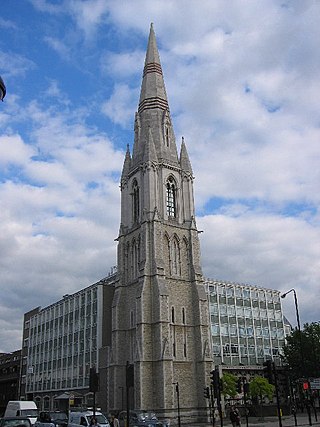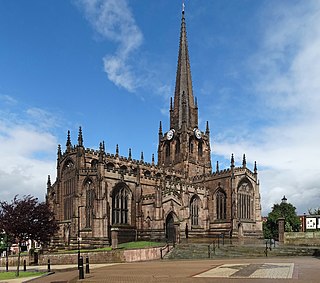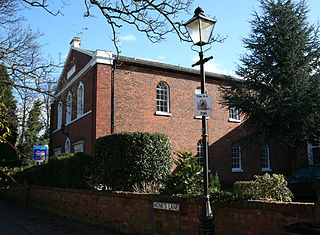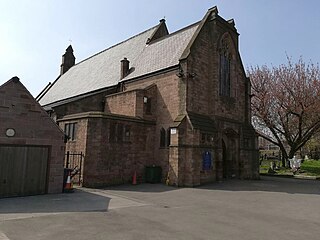Related Research Articles

The Metropolitan Borough of Rotherham is a metropolitan borough of South Yorkshire, England. It is named after its main settlement of Rotherham. The wider borough spans a larger area and covers the outlying towns of Maltby, Swinton, Wath-upon-Dearne, Dinnington. As well as the villages of Rawmarsh and Laughton. A large valley spans the entire borough and is referred to as the "Rother Valley".
The Primitive Methodist Church is a Methodist Christian denomination within the holiness movement. It began in England in the early 19th century, with the influence of American evangelist Lorenzo Dow (1777–1834).

Whitefield's sometimes Whitfield's Tabernacle is a former Calvinistic Methodist and Congregational church in Kingswood, a town on the eastern edge of Bristol where George Whitefield preached in the open air to coal miners. The name refers to two buildings in which the congregation met.

Greasbrough is a small suburb in Rotherham, in South Yorkshire, England. The suburb falls in the Greasbrough Ward of Rotherham Metropolitan Borough Council. Greasbrough had its own local council, Greasbrough UDC, until its absorption into the County Borough of Rotherham in 1936. Until 1974 it was in the West Riding of Yorkshire.

Wesley's Chapel is a Methodist church situated in the St Luke's area in the south of the London Borough of Islington. Opened in 1778, it was built under the direction of John Wesley, the founder of the Methodist movement. The site is a place of worship and visitor attraction, incorporating the Museum of Methodism in its crypt and John Wesley's House next to the chapel. The chapel has been called "The Mother Church of World Methodism".
The new Christian denomination of Methodists was formed in the early 18th century as a breakaway movement from the established Church of England. It was mainly formed by two Church of England ministers, John Wesley, the preacher and his brother, Charles Wesley, the hymn writer. The Methodist Church has had a following in Ripley from the formation of the earliest church up to the present day.

Masbrough is a suburb of Rotherham, South Yorkshire, England. It was named as the west of Rotherham by the middle of the Industrial Revolution, namely that part on the left bank of Don. Historically part of the West Riding of Yorkshire, it is in the Metropolitan Borough of Rotherham, centred 0.5 miles (0.8 km) west of Rotherham town centre. Much of the suburb falls within the Rotherham West ward of Rotherham MBC.
The Walker Mausoleum is located at 53.4313°N 1.3655°W on College Road, Rotherham, South Yorkshire, England. The sandstone mausoleum was built in the 1760s as the burial site for the families of Samuel and Aaron Walker and is now a Grade II listed building.

Christ Church, Lambeth, England, was founded by the Rev Dr Christopher Newman Hall in 1876 as a Congregational chapel, on Westminster Bridge Road. It drew its congregation largely from Surrey Chapel.

The Minster Church of All Saints or Rotherham Minster is the Anglican minster church of Rotherham, South Yorkshire, England. The Minster is a prominent example of Perpendicular Gothic architecture and various architectural historians have rated it highly. Nikolaus Pevsner describes it as "one of the largest and stateliest churches in Yorkshire", Simon Jenkins states it is "the best work in the county", and Alec Clifton-Taylor calls it the "glory of Rotherham". With its tall spire, it is Rotherham's most predominant landmark, and amongst the tallest churches in Yorkshire.
Dukinfield Moravian Church was founded in Dukinfield, Cheshire, England in 1755 following a period of evangelistic work in the area by Moravians from 1742. It now stands within the Tameside Metropolitan Borough, Greater Manchester.

The Wesleyan Methodist Church, also known as the Wesleyan Chapel, is a former Wesleyan Methodist church on Hospital Street, Nantwich, Cheshire, England. Built in 1808, a new façade was added in 1876. The church then seated over a thousand, and was the largest Nonconformist place of worship in the town in the 1880s. It is listed at grade II. The church closed in 2009, after the congregation moved to the former Methodist schoolrooms opposite.

The Congregational Chapel, also known as the Independent Chapel, is a former Congregational or Independent church in Nantwich, Cheshire, England. It is located on Monks Lane, now a pedestrian walkway, opposite the Dysart Buildings and immediately north east of St Mary's Church. Built in 1841–42, it is listed at grade II. The chapel closed in the late 20th century, and the building has been converted to residential use.
The Masbrough boat disaster was a disaster that occurred in a boatyard on the River Don in Masbrough, Yorkshire, now a suburb of Rotherham, on 5 July 1841. The disaster occurred during the launching of a new boat: sixty-four people, mainly children were drowned in the river.

John Clayton (1754–1843) was an English Independent minister. He became known for his conservative social views, after the Priestley Riots.

St Bede's Church is a Roman Catholic parish church in Rotherham, South Yorkshire, England. The Gothic Revival style church, designed by Weightman and Hadfield, is situated on the corner of Station Road and St Bede's Road in Masbrough near the town centre. Built from 1841 to 1842, it was opened eight years before the Restoration of the English hierarchy in 1850.

Skinner Street United Reformed Church is the oldest church in Poole, Dorset, England. The current building is the only eighteenth century church building in Poole, and is a Grade II* listed building. The church has a grave for Cyril Coles, one of the gunners in the first tank attack in 1916. The church is used as an adult learning centre.

Rotherham Town Hall is a municipal building in The Crofts, off Moorgate Street in Rotherham, South Yorkshire, England.

Vale Royal Methodist Church, also historically Vale Royal Chapel and Vale Royal Wesleyan Methodist Church, was a Methodist Church of Great Britain parish church in Royal Tunbridge Wells, Kent, England. It was opened in 1873 and stopped being used as a church on Easter 2015. It was later renovated to become a gym.
References
- 1 2 Historic England. "Premises of Allans of Rotherham (1286858)". National Heritage List for England . Retrieved 7 October 2014.
- 1 2 3 4 5 Website of the Friends of Masbro Chapel and Walker Mausoleum, www.walkermausoleum.co.uk Retrieved 20 August 2014
- 1 2 3 Wadsworth, KW, Yorkshire United Independent College Independent Press, London, 1954
- ↑ This Jonathan Walker (lived 1756/7-1807) was the son of the Jonathan Walker who lived 1742–1793